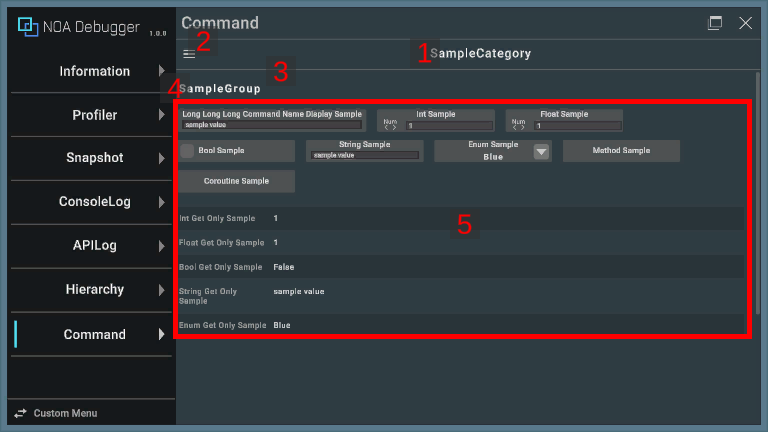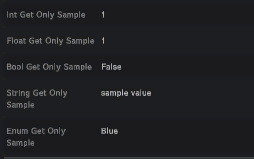DebugCommand
Displays the debug commands set.
Debug commands can be set and registered within an application that incorporates the NOA Debugger, allowing for the execution of methods, display of properties, etc. For how to set up debug commands, please refer to Setting Debug Commands described later.
Screen Layout and Operating Instructions

1. Category Name
Displays the category name you have selected.
2. Select Category Button
The category selection dialog is displayed by pressing the [≡] button.
3. Group Name
Displays the group name of debug commands.
4. Group Toggle
Select the group to be displayed in the floating window.
Commands of the group with a check will be displayed in the floating window.
5. Commands
Displays the debug commands set. The UI configuration of the commands to be displayed changes depending on the settings.
For details on each command, please refer to Command UI described later.
Command UI
IntProperty, FloatProperty
This is the command element displayed when the int or float property is specified. You can change the value by text input or increase/decrease the value by dragging.

StringProperty
This is the command element displayed when the string property is specified. You can change the value by text input.

BoolProperty
This is the command element displayed when the bool property is specified. You can change the value using the toggle.
EnumProperty
This is the command element displayed when the enum property is specified. You can change the value using the dropdown.

Method
This is the command element displayed when a method is specified. Pressing the button executes the specified method.
In the case of asynchronous, the button cannot be pressed until the process is completed.
GetOnlyProperty
This is the command element displayed when there is a public getter in the property. GetOnlyProperty is displayed at the bottom within the same group.

Setting Debug Commands
Create a class that inherits DebugCategoryBase within an application that incorporates the NOA Debugger.
When using the functions provided by the NOA Debugger, always use the symbol definition of NOA_DEBUGGER.
The properties and methods within the created class that meet the following conditions will be displayed on the DebugCommand screen.
Properties to Be Displayed
- Has a
publicgetter. - Owns either
int,float,string,bool, orenumtype.
Methods to Be Displayed
- Method is public.
- Has either
IEnumerator,NoaDebugger.MethodHandler, orvoidas a return value. - No parameters are set.
Note: For a description of NoaDebugger.MethodHandler, refer to About MethodHandler.
Sample Code of Category Class
#if NOA_DEBUGGER
using NoaDebugger;
public class DebugCommandSample : DebugCategoryBase
{
public void ExampleMethod()
{
// Do something.
}
// Property
[CommandGroup("Group1"), DisplayName("Property1"), SaveOnUpdate]
public int ExampleProperty1
{
get;
set;
}
// GetOnlyProperty
[CommandGroup("Group1"), DisplayName("Property2"), SaveOnUpdate]
public int ExampleProperty2
{
get;
private set;
}
}
#endif
Registering a Category Class
To display the created class on the DebugCommand screen, call `NoaDebugger.DebugCommandRegister.AddCategory() within the application that incorporated the NOA Debugger and register the created class.
You can specify a category name as the argument to AddCategory(). The specified string will be displayed on the NOA Debugger. If nothing is specified, the class name will be displayed.
You can specify the order as the argument to AddCategory(). Categories are displayed in the list from the ones with the smallest specified value. If no value is specified, they will be listed behind the categories that specified the order, in the order they were loaded.
If you register multiple categories with the same name, suffixes such as -1 and -2 will be automatically added.
#if NOA_DEBUGGER
using NoaDebugger;
#endif
public class Example
{
void Initialize()
{
#if NOA_DEBUGGER
DebugCommandRegister.AddCategory<DebugCommandSample>("CategoryName", 1);
#endif
}
}
Conditions for the category classes to be displayed
The classes that can be registered on the DebugCommand screen have the following conditions:
- Able to create an instance without arguments.
Reference to Instances of a Registered Category
To reference an instance of a category registered with NoaDebugger.DebugCommandRegester.AddCategory(), call NoaDebugger.DebugCommandRegister.GetCategoryInstance() inside an application that has incorporated the NOA Debugger.
#if NOA_DEBUGGER
using NoaDebugger;
using UnityEngine;
#endif
public class Example
{
void AccessToDebugCategoryInstance()
{
#if NOA_DEBUGGER
// Specify the category name you specified at the time of registration as the argument.
var instance = DebugCommandRegister.GetCategoryInstance<DebugCommandSample>("CategoryName");
instance.ExampleMethod();
Debug.Log($"Value: {instance.ExampleProperty}");
// Because suffixes such as '-1' and '-2' are automatically added when registering with the same name,
// it is necessary to reflect it in specifying the category name to retrieve, as well.
var anotherInstance = DebugCommandRegister.GetCategoryInstance<DebugCommandSample>("CategoryName-1");
#endif
}
}
Updating Property Values
When the value of a property is changed from a method, you cannot update the rendering unless you display the DebugCommand function again.
If you want to update the drawing immediately, please execute NoaDebugger.DebugCommandRegister.RefreshProperty() within the method.
#if NOA_DEBUGGER
using NoaDebugger;
public class DebugCommandSample : DebugCategoryBase
{
int _exampleProperty;
[CommandGroup("Group1"), DisplayName("Property1")]
public int ExampleProperty
{
get => _exampleProperty;
}
public void ExampleMethod()
{
_exampleProperty = 2;
// Update displayed property value.
DebugCommandRegister.RefreshProperty();
}
}
#endif
Save Property Values
By adding the SaveOnUpdateAttribute attribute to the properties to be displayed, you can save the changed values.
Delete Saved Property Values
By calling the following API, you can delete the values of the properties you have saved:
NoaDebugger.DebugCommandRegister.DeleteSavedProperty(categoryName, propertyName)NoaDebugger.DebugCommandRegister.DeleteAllPropertiesInCategory(categoryName)NoaDebugger.DebugCommandRegister.DeleteAllSavedProperties()
Specify the category name you specified when executing NoaDebugger.DebugCommandRegister.AddCategory() in categoryName, and specify the target property name in propertyName.
#if NOA_DEBUGGER
// Delete the saved value of the specified category and property name.
DebugCommandRegister.DeleteSavedProperty("CategoryName", nameof(Property));
// Delete the saved values of all properties in the specified category.
DebugCommandRegister.DeleteAllPropertiesInCategory("CategoryName");
// Deletes the saved values of all properties.
DebugCommandRegister.DeleteAllSavedProperties();
#endif
Attributes That Can Be Specified in the Debug Command
The attributes that can be specified in the debug command are as follows:
| Attribute | Description |
|---|---|
CommandGroupAttribute | Specifies the group of the target command. If not specified, it will be included in 'Others'. |
DisplayNameAttribute | Specifies the display name of the target command. If not specified, the property name or method name will be displayed. |
CommandOrderAttribute | Specifies the order of the target command. They are displayed in order from the smallest specified value. |
CommandInputRangeAttribute | Specifies the input range for int and float properties. |
CommandIncrementAttribute | Specifies the amount by which int and float properties will increase or decrease during drag operations. If not specified, the value increases or decreases by 1. |
CommandCharacterLimitAttribute | Specifies the upper limit of the number of input characters for string properties. |
SaveOnUpdateAttribute | Saves the target property to the specified key. If not specified, the value of property will not be saved. |
CommandExcludeAttribute | Excludes properties and methods that meet the display criteria from the display targets. |
Adding Dynamic Debug Commands
By using the following APIs defined in the NoaDebugger.DebugCommandRegister class, you can dynamically add properties and methods of classes that do not inherit from DebugCategoryBase as debug commands.
Create a command definition:
// Creates a property command definition that has only getter.
CommandDefinition CreateGetOnlyIntProperty(string categoryName, string displayName, Func<int> getter, Attribute[] attributes = null);
CommandDefinition CreateGetOnlyFloatProperty(string categoryName, string displayName, Func<float> getter, Attribute[] attributes = null);
CommandDefinition CreateGetOnlyStringProperty(string categoryName, string displayName, Func<string> getter, Attribute[] attributes = null);
CommandDefinition CreateGetOnlyBoolProperty(string categoryName, string displayName, Func<bool> getter, Attribute[] attributes = null);
CommandDefinition CreateGetOnlyEnumProperty(string categoryName, string displayName, Func<Enum> getter, Attribute[] attributes = null);
// Creates a property command definition that has only getter and setter.
CommandDefinition CreateMutableIntProperty(string categoryName, string displayName, Func<int> getter, Action<int> setter, Attribute[] attributes = null);
CommandDefinition CreateMutableFloatProperty(string categoryName, string displayName, Func<float> getter, Action<float> setter, Attribute[] attributes = null);
CommandDefinition CreateMutableStringProperty(string categoryName, string displayName, Func<string> getter, Action<string> setter, Attribute[] attributes = null);
CommandDefinition CreateMutableBoolProperty(string categoryName, string displayName, Func<bool> getter, Action<bool> setter, Attribute[] attributes = null);
CommandDefinition CreateMutableEnumProperty<T>(string categoryName, string displayName, Func<T> getter, Action<T> setter, Attribute[] attributes = null) where T : Enum;
// Creates a method command definition.
CommandDefinition CreateMethod(string categoryName, string displayName, Action method, Attribute[] attributes = null);
// Creates a coroutine command definition.
CommandDefinition CreateCoroutine(string categoryName, string displayName, Func<IEnumerator> coroutine, Attribute[] attributes = null);
// Creates a handle-method command definition.
CommandDefinition CreateHandleMethod(string categoryName, string displayName, Func<MethodHandler> method, Attribute[] attributes = null);
For each API's attributes, you can specify attributes that can be specified in the debug command, excluding the following attributes:
DisplayNameAttributeSaveOnUpdateAttributeCommandExcludeAttribute
Adding and removing commands using the created command definition:
// Adds a command by using created command definition.
void AddCommand(CommandDefinition commandDefinition);
// Removes a added command.
// Please use this API to remove the commands you have added when the objects related to the command are disposed.
void RemoveCommand(CommandDefinition commandDefinition);
The sample code to dynamically add and remove debug commands is as follows.
Properties with only a getter:
#if NOA_DEBUGGER
using System;
using NoaDebugger;
using UnityEngine;
public class DynamicDebugCommand : MonoBehaviour
{
readonly int constantValue = 0;
CommandDefinition commandDefinition = null;
// Creates and registers a command.
void Start()
{
var attributes = new Attribute[]
{
new CommandGroupAttribute("Dynamic Command Group"),
new CommandOrderAttribute(0)
};
commandDefinition = DebugCommandRegister.CreateGetOnlyIntProperty(
"Dynamic Command Category",
"Get-Only Property",
() => constantValue,
attributes);
DebugCommandRegister.AddCommand(commandDefinition);
}
// Removes a registered command.
void OnDestroy() => DebugCommandRegister.RemoveCommand(commandDefinition);
}
#endif
Properties with getter and setter:
#if NOA_DEBUGGER
using System;
using NoaDebugger;
using UnityEngine;
public class DynamicDebugCommand : MonoBehaviour
{
int mutableValue = 0;
CommandDefinition commandDefinition = null;
// Creates and registers a command.
void Start()
{
var attributes = new Attribute[]
{
new CommandGroupAttribute("Dynamic Command Group"),
new CommandOrderAttribute(0)
};
commandDefinition = DebugCommandRegister.CreateMutableIntProperty(
"Dynamic Command Category",
"Mutable Property",
() => mutableValue,
value => mutableValue = value,
attributes);
DebugCommandRegister.AddCommand(commandDefinition);
}
// Removes a registered command.
void OnDestroy() => DebugCommandRegister.RemoveCommand(commandDefinition);
}
#endif
Methods:
#if NOA_DEBUGGER
using System;
using NoaDebugger;
using UnityEngine;
public class DynamicDebugCommand : MonoBehaviour
{
CommandDefinition commandDefinition = null;
// Creates and registers a command.
void Start()
{
var attributes = new Attribute[]
{
new CommandGroupAttribute("Dynamic Command Group"),
new CommandOrderAttribute(0)
};
commandDefinition = DebugCommandRegister.CreateMethod(
"Dynamic Command Category",
"Method",
() => Debug.Log("Executing Dynamic Command."),
attributes);
DebugCommandRegister.AddCommand(commandDefinition);
}
// Removes a registered command.
void OnDestroy() => DebugCommandRegister.RemoveCommand(commandDefinition);
}
#endif
Coroutines:
#if NOA_DEBUGGER
using System;
using System.Collections;
using NoaDebugger;
using UnityEngine;
public class DynamicDebugCommand : MonoBehaviour
{
CommandDefinition commandDefinition = null;
// Creates and registers a command.
void Start()
{
var attributes = new Attribute[]
{
new CommandGroupAttribute("Dynamic Command Group"),
new CommandOrderAttribute(0)
};
commandDefinition = DebugCommandRegister.CreateCoroutine(
"Dynamic Command Category",
"Coroutine",
DebugCommandCoroutine,
attributes);
DebugCommandRegister.AddCommand(commandDefinition);
}
// Removes a registered command.
void OnDestroy() => DebugCommandRegister.RemoveCommand(commandDefinition);
// Coroutine called by a debug command.
IEnumerator DebugCommandCoroutine()
{
yield return new WaitForSeconds(1);
}
}
#endif
Handle-method:
#if NOA_DEBUGGER
using System;
using NoaDebugger;
using UnityEngine;
public class DynamicDebugCommand : MonoBehaviour
{
MethodHandler handler = new();
CommandDefinition commandDefinition = null;
// Creates and registers a command.
void Start()
{
var attributes = new Attribute[]
{
new CommandGroupAttribute("Dynamic Command Group"),
new CommandOrderAttribute(0)
};
commandDefinition = DebugCommandRegister.CreateHandleMethod(
"Dynamic Command Category",
"Handle Method",
DebugCommandHandleMethod,
attributes);
DebugCommandRegister.AddCommand(commandDefinition);
}
// Removes a registered command.
void OnDestroy() => DebugCommandRegister.RemoveCommand(commandDefinition);
// Handle-method called by a debug command.
MethodHandler DebugCommandHandleMethod()
{
handler.IsDone = false;
return handler;
}
// Completes handle-method.
void CompleteHandleMethod() => handler.IsDone = true;
}
#endif
Using Unity Test Runner
You can retrieve the instance of the registered category class and use it for testing only during PlayMode.
#if NOA_DEBUGGER
using System.Collections;
using UnityEngine.TestTools;
using NoaDebugger;
public class Example
{
[UnityTest]
public IEnumerator Test()
{
NoaDebug.Initialize();
DebugCommandRegister.AddCategory<DebugCommandSample>();
var instance = DebugCommandRegister.GetCategoryInstance<DebugCommandSample>();
instance.ExampleMethod();
yield return null;
}
}
#endif
